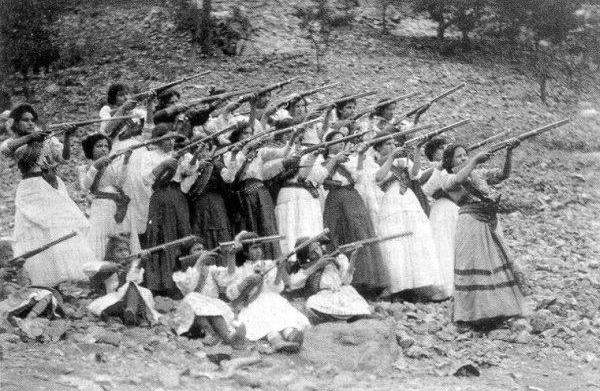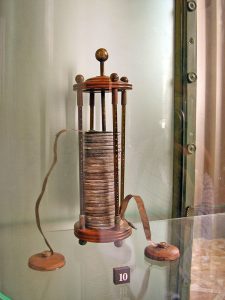Winner of the Spring 2018 StMU History Media Award for
Best Article in the Category of “Gender Studies”
“La Adelita” was one of the most popular corridos, or songs of romance, during the Mexican Revolution (1910-1920).1 This song is the love story of a young woman who travels with a sergeant and his regiment during the revolution.2 The song praises Adelita, the sweetheart of the troop, for both her beauty and her valor, noting how she is wanted by the other soldiers. We can imagine this woman as an object of desire, whose beauty and physique attracted the soldiers, and eventually broke their hearts. But this description is actually… incorrect.3
The Adelita, also known as soldadera, or female soldier, is the term used to describe women who contributed to many aspects of the Mexican Revolution. These women worked as nurses, food providers, lovers, spies, messengers, and fighters.4 In fact, some reached the rank of colonel and general. Many of them were forced by their husbands to follow them and work in the camps, but there were also those who volunteered to join the cause.5 Today, soldaderas are remembered as strong and courageous women who took up weapons and became fighters, often having to cut their hair and dress to appear like their male counterparts, because of the oppressive gender inequality prevalent in the Mexican society of that time.6 There is one soldadera in particular, Petra Herrera, also known as La Guerrera, and as La Generala (female general), who joined the cause and fought with the strongest of the soldiers. But what inspired women to join their male counterparts to fight this war, and why did the revolution even happen?

To answer this question and to be able to understand why these women now make up a very important aspect of Mexico’s history and its formation as a country, we need to go back in time to 1876, when the general and politician Porfirio Díaz became president. Porfirio Díaz was known to be a corrupt, elitist president, who favored wealthy landowners, industrialists, and foreign interests.7 The country was also known for the slave-like conditions rural people faced while working on the haciendas owned by wealthy landowners.8 These rural workers were very dissatisfied with the lack of voice they had in the government. But the precipitating event that sparked the revolution was Díaz’s announcement, in 1908, that he would run for his seventh term as president in 1910. This caused controversy among the people who had been suffering from his long regime. Francisco I. Madero then rose as the leader of the Antireeleccionistas (Anti-Reelection alliance). Madero subsequently announced that he would be running for president against Díaz. This prompted the mobilization of armies throughout Mexico. Countless leaders, such as Pascual Orozco and Pancho Villa, began raiding government garrisons as part of an uprising to remove the current president and eventually, elect a new president for the country.9 These were some of the events that inspired and sparked the courage of not only men but of women as well, to join the armies and fight for the shared goal of overthrowing Díaz’ dictatorship and make democracy in Mexico a reality.10

Petra Herrera witnessed the suffering of her country and decided to take action. She witnessed the harshness of landowners and the terrible conditions in which workers lived. She knew that the government had to change from being a corrupt one to being a democratic and fair one. But how would she help? Women at that time faced strict social prohibitions that kept them from playing important roles in the workforce. Instead, they were expected to be caregivers, stay at home, and take care of their children. Women were seen as precious and delicate, something that could not blend with the harshness of war. Petra, instead of following that norm, disguised herself as a man and started calling herself “Pedro Herrera” in order to join the revolutionary troops of Pancho Villa.11
During her time in the camp, she had to lie to her fellow soldiers in order to protect her identity. For example, she would lie that she shaved at dawn before the other soldiers woke up.12 Because of this, “Pedro” was able to blend in perfectly. Quickly after her joining the army, Petra was recognized as an aggressive fighter who carried out military operations efficiently and strategically. In disguise, she came to be known as a courageous and brave soldier, and was soon praised for her intelligence and her skills at blowing up bridges.

Thanks to the acknowledgment she faced on behalf of her peers and her establishment as a strong soldier, Petra decided she would confess her true identity. She believed this would not affect her position or status in the militia, and that she would be accepted and even promoted to general. But sadly, when she told the truth, she was removed from the army instead.13 Consequently, she decided to organize a group of women who were likewise removed from combat, even after they had fought courageously for the same cause as their male counterparts. Petra decided not to give up, and she organized a group of more than four hundred women with the same motive: to put an end to the current presidency and the hardships that Díaz had imposed on the citizens. Her militia not only fought in several battles, but Petra united these fighting women with Pancho Villas’ forces, despite his denial of them fighting and bearing arms. Together, they were able to take the city of Torreón on May 30, 1914, which had been a military base for Díaz’s central federation.14 At the end of the fight, she requested General Castro, a leader of the revolution, to allow her to re-enter the military and make her general, but he only granted her the title of colonel and disbanded her woman’s brigade.15 But her work did not end there. After the demobilization of the woman’s militia, Petra decided to join Venustiano Carranza, one of the main political leaders of the revolution who later became president of Mexico. She became a spy for him and worked as a bartender in Jimenez, a city in the northern part of Mexico.16 But while she was working there, she was shot three times by a group of drunk men, later dying from the injuries.
Despite the effort and the work Petra Herrera gave for the revolution, she has barely received any acknowledgment as a soldadera. There are several causes for this. Men during those times had mixed feelings about women being in combat and the role they had in the fight.17 One of the most passionate opponents of women joining the militia and bearing arms was Pancho Villa. He viewed women as liabilities to an army’s offensive strategy and combative potential, even though Petra Herrera and other great female combatants fought at his side several times to free the country from the oppressive presidency.18 There was also the idea that soldaderas were just images of romance during the Mexican Revolution, such as the song of “The Adelita,” contributing to recognizing only a few of them as strong fighters and contributions to this era.19 These women should be acknowledged and we should grant them a higher praise because many were forced to take this role of soldaderas after being abducted and often raped by revolutionaries who invaded their towns and cities. At the end of the day, the labor and effort of women such as Petra were very important factors for what we have come to know as the Mexican Revolution.
Hear the ballad of La Adelita
La Adelita
Spanish20
Little Adela
English translation21
- Beatriz de León, “La Adelita: El Rostro de La Soldadera,” in Reforma (Mexico D.F., Mexico), 2010. ↵
- Beatriz de León, “La Adelita: El Rostro de La Soldadera,” Reforma (Mexico D.F., Mexico), 2010. ↵
- Andrés Reséndez Fuentes, “Battleground Women: Soldaderas and Female Soldiers in the Mexican Revolution,” The Americas, no. 4, (1995): 55-57. ↵
- Oxford Research Encyclopedias, May 9, 2016, s.v. “Working Women in the Mexican Revolution,” by Susie S. Porter. ↵
- Donna Seaman, “Las Soldaderas: Women of the Mexican Revolution,” Booklist 103, no. 12, (2007): 18. ↵
- Elizabeth Salas, Soldaderas in the Mexican Military: Myth and History (Austin, Tex.: University of Texas Press, 1990), 48-49. ↵
- Encyclopedia Britannica, October 25, 2017, s.v. “Mexico | History, Geography, Facts, & Points of Interest – The Mexican Revolution and Its Aftermath.” ↵
- Encyclopedia Britannica, January 2, 2018, s.v. “Mexican Revolution | Causes, Summary, & Facts.” ↵
- Encyclopedia Britannica, January 2, 2018, s.v. “Mexican Revolution | Causes, Summary, & Facts.” ↵
- Encyclopedia of Latin American History and Culture, January 2008 v.s. “Women,” by Francesca Miller and Meredith Glueck. ↵
- Delia Fernandez, “‘La Adelita’ Becomes an Archetype of the Mexican Revolution,” McNair Scholar Journal, Vol. 13, (2009): 57-58. ↵
- Jason Porath, Rejected Princesses: Tales of History’s Boldest Heroines, Hellions, and Heretics, (New York, NY.: Patreon, 2016), 123-124. ↵
- Elena Poniatowska, Las soldaderas: women of the Mexican revolution (El Paso: Cinco Punto Press, 2006), 45. ↵
- Encyclopedia Britannica, October 25, 2017, s.v. “Mexico | History, Geography, Facts, & Points of Interest – The Mexican Revolution and Its Aftermath.” ↵
- Jason Porath, Rejected Princesses: Tales of History’s Boldest Heroines, Hellions, and Heretics, (New York, NY.: Patreon, 2016), 123-124. ↵
- Jason Porath, Rejected Princesses: Tales of History’s Boldest Heroines, Hellions, and Heretics, (New York, NY.: Patreon, 2016), 123-124. ↵
- Wilma Mankiller, Marysa Navarro, and Gloria Steinem, “Feminism and Feminisms: Feminism,” in Reader’s Companion to U.S. Women’s History (Boston, 1998), 187. ↵
- Oxford Research Encyclopedias, May 9, 2016, s.v. “Working Women in the Mexican Revolution,” by Susie S. Porter. ↵
- Alicia Arrizón, “Soldaderas and the Staging of the Mexican Revolution,” TDR: The Drama Review 42, no. 1, (1998): 105–107. ↵
- Amparo Ochoa, “La Adelita,” Corridos Y Canciones de la Revolucion Mexicana, Ediciones Pentagrama, 1995. Featured in video “La Adelita – Amparo Ochoa,” Courtesy of Youtube (https://www.youtube.com/watch?time_continue=64&v=hlGtOv-QEQQ ). ↵
- “La Adelita,” Mexican Folk Song, translation of last three stanzas by phantasmagoria ↵




127 comments
Monica Avila
I’m disappointed that I do not know the Mexican Revolution in great extent. This article did a great job at explaining the full history of Mexico, the Mexican Revolution, and the female’s roles in advancing the revolution. It inspired me to read about Petra and all her perseverance, and unwillingness to give in to the oppressors. The part where to dressed like a man to fight for their freedom, reminded me of Mulan, and that was my favorite part of the whole article.
Tyler Sleeter
Really great article. I know very little about the Mexican Revolution and I have never heard of the adelitas or Petra Herrera, and I really enjoyed the information in your article. It seems that although Petra Herrera demonstrated her skills as “male” soldier and had earned the respect of her fellow soldiers and leaders, she could not be accepted once she confessed her true gender. I liked the song, and I am glad you included the translation. I think it is great that these brave, tough, and strong women are getting the credit they deserve for their contribution to history.
Rolando Mata
fantastic article, I was never really educated on the Mexican revolution as much as I thought I should’ve learned but this article helped push me a little in the right direction. this article, for those reasons, was very educational and taught me about a subject that I had never before heard of or even contemplated. women in the Mexican revolution was never a concept I had ever heard of before but I am glad that I know now.
Vanessa Tombo
This article is extremely well written. It depicted the struggles and the accomplishment that women played in the Mexican Revolution (1910-1920). Which is not something I knew of the Mexican revolution. This article showcases a character many are not familiar with, it show the hardships that Petra went through and how she continued to push for more opportunities in order to achieve what she believed was right. This article was extremely well written educational.
Alexandra Cantu
This was such an amazing article. it was totally new and unique. I loved that you incorporated the Ballad of La Adelita in both English and Spanish. I had never heard of the Mexican revolution. This article provide a plethora of information and still managed to keep my attention about Mexican history. Petra was denied so many opportunities because of being a women. Even with all her hardships she persevered. Thank you for sharing your knowledge about the Mexician Revolution.
Carlos Vazquez
I had never heard the story of Petra Herrera and her struggles during the Mexican revolution. The revolution was one of the most troubling times in Mexican history when the people fought to overthrow their dictator in order to have a better life. This article is very well written and informative, I really enjoyed reading this article and learning more about the contribution of women like Petra to the revolution.
Cristina Cabello
This is a really good article. I like to read about people making a change. In this case Petra made Mexican history. By doing so she is now a huge role model of how women should be. Or to keep in mind. The Mexican Revolution is pretty long and a lot to understand. But this article did a really great job on giving the insight of it. Women have so much potential.
Cheyanne Redman
This article was very well written and the efforts implemented shines through immensely. I don’t have much prior knowledge regarding the Mexican Revolutions and the history of Mexico but after reading I feel I know more than I did. I had no idea of Petra and how she disguised herself as a man to fight for her freedom, and to me that really shows dedication. Amazing article.
Nathan Hudson
Great, well-written article. It is interesting to read about the many women throughout history who have made strides in gender equality. It is intriguing how many women in the revolution actually became a soldadera, since Mexico seems to have such a patriarchal culture and society. I enjoyed reading the ballad and I think that it was a good choice to add to the article.
Edgar Ramon
I’m pretty familiar with this part of Mexican history, and I agree with you that the Adelita was more of the myth created. Obviously women either fought, or provided several services (food, laundry, nursing, etc.) for the army, and the Adela was an idealization, probably starting from a somewhat true story. From what I have been able to read, and learn, they were very important to the soldiers’ morale, gave them hope, and something to create songs about. Mexican soldiers were very poetic, music was a big part of war.